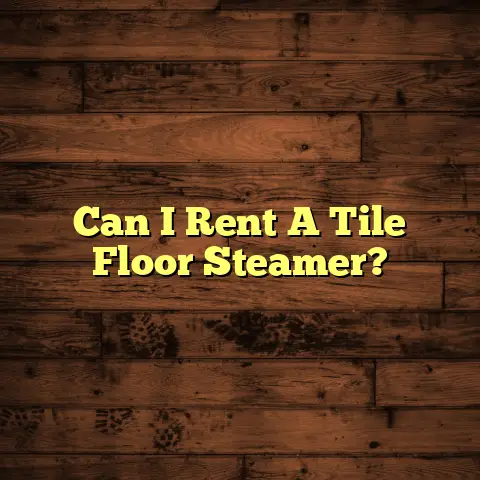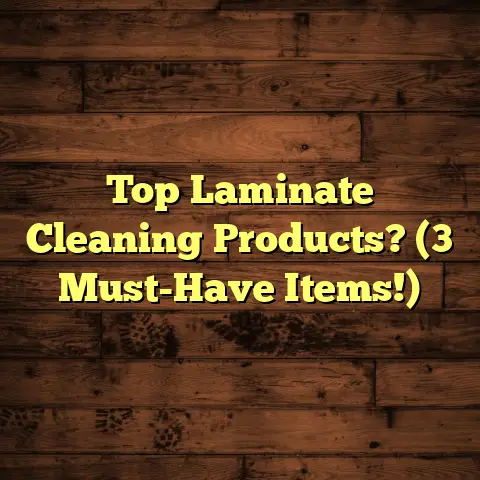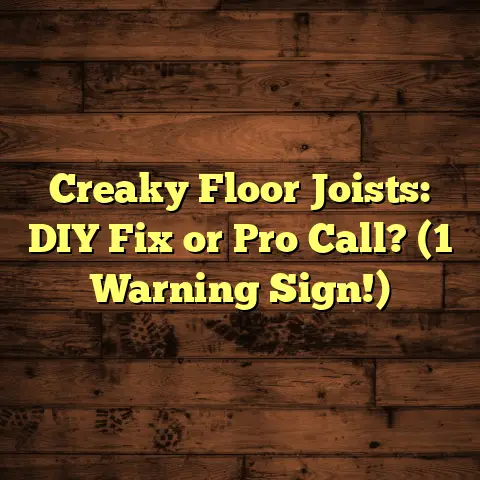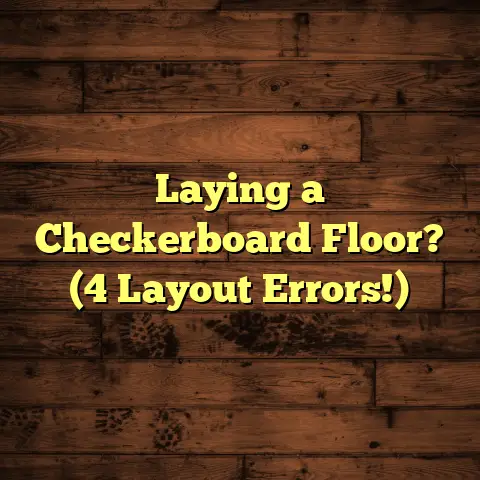Wood Floor Finishing (8 Pro Options!)
As a flooring contractor with years of experience, I’m here to tell you that wood floor finishing is an art and a science. It’s not just about slapping on a coat of something shiny; it’s about protecting your investment and making your floors look amazing for years to come.
So, grab a cup of coffee (or something stronger!), and let’s dive into the world of wood floor finishing. I’m going to walk you through eight professional options that will transform your floors from drab to fab!
The Importance of Wood Floor Finishing
Okay, so what exactly is wood floor finishing? Simply put, it’s the process of applying a protective layer to your wood floors after they’ve been sanded and prepped. Think of it as the topcoat for your nails or the clear coat on your car.
But why is it so important? Well, unfinished wood is like a sponge. It soaks up moisture, gets scratched easily, and basically becomes a magnet for dirt and grime. A good finish acts as a shield, preventing damage from:
-
Moisture: Water is the enemy of wood. Finishing helps prevent warping, swelling, and even mold growth.
-
Scratches: From pets to furniture to clumsy humans (like myself!), scratches are inevitable. A tough finish minimizes these scratches and keeps your floors looking newer for longer.
-
Everyday Wear and Tear: Foot traffic, spills, and general use can take a toll on your floors. A finish provides a durable barrier against this wear and tear.
A well-finished floor is like a well-dressed person. It’s protected, polished, and makes a great impression! Plus, it increases the value of your home. Who doesn’t want that?
Overview of Wood Floor Finishing Options
Alright, let’s talk about the fun part: the options! Choosing the right finish can feel overwhelming. It’s like standing in front of a buffet of delicious dishes, each with its own unique flavor and appeal.
Here’s a quick rundown of the eight professional options we’ll be covering:
-
Polyurethane Finish: The workhorse of wood floor finishes, known for its durability and affordability.
-
Oil-Based Finish: Enhances the natural beauty of the wood and provides a rich, warm tone.
-
Water-Based Finish: A low-VOC option that dries quickly and offers excellent clarity.
-
UV-Cured Finish: The speed demon of finishes, curing instantly with UV light.
-
Shellac Finish: A classic, traditional finish that adds character and charm.
-
Lacquer Finish: A high-gloss finish that creates a sleek and modern look.
-
Penetrating Oil Finish: A natural finish that soaks into the wood and provides a soft, matte look.
-
Hardwax Oil Finish: A hybrid finish that combines the benefits of oil and wax for durability and beauty.
Ready to dig in? Let’s get started!
Option 1 – Polyurethane Finish
Polyurethane is like the Swiss Army knife of wood floor finishes. It’s versatile, durable, and relatively affordable. It’s a synthetic resin that forms a tough, protective layer over your wood floors.
Pros:
-
Durability: Polyurethane is highly resistant to scratches, scuffs, and water damage. It’s a great choice for high-traffic areas.
-
Affordability: Compared to some other options, polyurethane is relatively inexpensive.
-
Variety of Sheens: You can choose from matte, satin, semi-gloss, or gloss finishes to achieve your desired look.
Cons:
-
Strong Odor: Polyurethane can have a strong, lingering odor during application. Proper ventilation is essential.
-
Yellowing: Oil-based polyurethanes can yellow over time, especially in areas with direct sunlight.
-
Difficult to Repair: Spot repairs can be tricky, as the new polyurethane may not blend seamlessly with the old.
Polyurethane can make your floors shine like they just walked off a Hollywood set! But remember, with great shine comes great responsibility.
Application Tips:
-
Prep is Key: Sand your floors thoroughly and remove all dust and debris.
-
Apply Thin Coats: Multiple thin coats are better than one thick coat. This prevents bubbles and ensures even coverage.
-
Use a High-Quality Applicator: A good brush or roller will help you achieve a smooth, even finish.
-
Ventilate: Open windows and use fans to ensure proper ventilation during application and drying.
Maintenance:
-
Sweep or Vacuum Regularly: This removes dirt and debris that can scratch the finish.
-
Use a Damp Mop: Clean spills promptly with a damp mop and a mild detergent.
-
Avoid Harsh Chemicals: Don’t use abrasive cleaners or solvents, as they can damage the finish.
Option 2 – Oil-Based Finish
Oil-based finishes are like a fine wine. They enhance the natural beauty of the wood and provide a rich, warm tone that’s hard to resist. These finishes penetrate the wood fibers, creating a durable and long-lasting finish.
Pros:
-
Rich Color Enhancement: Oil-based finishes bring out the natural grain and color of the wood, creating a warm and inviting look.
-
Durability: These finishes are highly resistant to wear and tear, making them a good choice for high-traffic areas.
-
Easy to Repair: Spot repairs are relatively easy, as the new finish will blend in well with the old.
Cons:
-
Long Drying Time: Oil-based finishes can take a long time to dry, sometimes up to 24 hours between coats.
-
Strong Odor: These finishes have a strong odor that can linger for days. Proper ventilation is essential.
-
Yellowing: Like oil-based polyurethanes, oil-based finishes can yellow over time.
Using oil-based finishes can turn anyone into a ‘floor artist’ with just the right touch! Just remember to be patient and let the finish work its magic.
Application Steps:
-
Sand the Floors: Start with a coarse grit sandpaper and gradually move to a finer grit.
-
Clean the Floors: Remove all dust and debris with a vacuum and a tack cloth.
-
Apply the Finish: Use a brush, roller, or cloth to apply a thin, even coat of finish.
-
Wipe Off Excess: After a few minutes, wipe off any excess finish with a clean cloth.
-
Allow to Dry: Let the finish dry completely before applying another coat.
Care Instructions:
-
Sweep or Vacuum Regularly: This removes dirt and debris that can scratch the finish.
-
Use a Damp Mop: Clean spills promptly with a damp mop and a mild detergent.
-
Wax Periodically: Applying a coat of wax every few months can help protect the finish and maintain its luster.
Option 3 – Water-Based Finish
Water-based finishes are the eco-friendly choice for wood floor finishing. They’re low in VOCs (volatile organic compounds), dry quickly, and offer excellent clarity. Think of them as the responsible, yet stylish, option.
Pros:
-
Low VOCs: Water-based finishes have a lower odor and are better for the environment than oil-based finishes.
-
Quick Drying Time: These finishes dry much faster than oil-based finishes, allowing you to complete your project in less time.
-
Excellent Clarity: Water-based finishes don’t yellow over time, so your floors will maintain their natural color.
Cons:
-
Less Durable: Water-based finishes are generally less durable than oil-based finishes, although high-quality options are available.
-
Can Raise the Grain: Water-based finishes can raise the grain of the wood, requiring additional sanding.
-
More Expensive: Water-based finishes are typically more expensive than oil-based finishes.
Choosing between water-based and oil-based finishes is like choosing between a quick coffee break and a leisurely wine tasting. Both have their advantages, depending on your preferences and needs.
Application Tips:
-
Sand the Floors: Sand your floors thoroughly and remove all dust and debris.
-
Apply a Sealer: Applying a sealer before the finish can help prevent the grain from raising.
-
Apply Thin Coats: Multiple thin coats are better than one thick coat.
-
Use a Synthetic Applicator: Use a synthetic brush or roller to apply the finish.
Maintenance:
-
Sweep or Vacuum Regularly: This removes dirt and debris that can scratch the finish.
-
Use a Damp Mop: Clean spills promptly with a damp mop and a mild detergent.
-
Use a pH-Neutral Cleaner: Avoid using acidic or alkaline cleaners, as they can damage the finish.
Option 4 – UV-Cured Finish
UV-cured finishes are the superheroes of the wood floor finishing world. They dry instantly with UV light, allowing you to walk on your floors almost immediately. Talk about convenience!
Pros:
-
Instant Drying: UV-cured finishes dry instantly, saving you time and hassle.
-
Extreme Durability: These finishes are highly resistant to scratches, scuffs, and water damage.
-
Low VOCs: UV-cured finishes are low in VOCs and are better for the environment than some other options.
Cons:
-
Expensive: UV-cured finishes are one of the most expensive options available.
-
Requires Special Equipment: Applying UV-cured finishes requires specialized equipment, including a UV curing lamp.
-
Difficult to Repair: Spot repairs can be tricky, as the new finish may not blend seamlessly with the old.
UV finishes could revolutionize a busy family’s life, making it more like a superhero story. Imagine refinishing your floors in the morning and hosting a party that evening!
Application Process:
-
Sand the Floors: Sand your floors thoroughly and remove all dust and debris.
-
Apply the Finish: Use a specialized applicator to apply a thin, even coat of finish.
-
Cure with UV Light: Use a UV curing lamp to cure the finish.
-
Inspect the Finish: Check for any imperfections and apply another coat if necessary.
Maintenance:
-
Sweep or Vacuum Regularly: This removes dirt and debris that can scratch the finish.
-
Use a Damp Mop: Clean spills promptly with a damp mop and a mild detergent.
-
Avoid Harsh Chemicals: Don’t use abrasive cleaners or solvents, as they can damage the finish.
Option 5 – Shellac Finish
Shellac is a classic, traditional finish that adds character and charm to wood floors. It’s made from a resin secreted by the lac beetle and has been used for centuries. It’s like stepping back in time with a touch of elegance.
Pros:
-
Natural and Non-Toxic: Shellac is a natural, non-toxic finish that’s safe for your family and the environment.
-
Easy to Apply: Shellac is easy to apply and dries quickly.
-
Repairable: Spot repairs are relatively easy, as the new finish will blend in well with the old.
Cons:
-
Not Very Durable: Shellac is not as durable as some other finishes and is susceptible to water damage and scratches.
-
Alcohol Sensitive: Shellac is soluble in alcohol, so spills of alcohol-based liquids can damage the finish.
-
Can Be Brittle: Shellac can become brittle over time and may require periodic reapplication.
Using shellac might make one feel like they’ve traveled back in time to the days of woodworkers and craftsmen. It’s a finish with a story to tell.
Application Techniques:
-
Sand the Floors: Sand your floors thoroughly and remove all dust and debris.
-
Apply the Shellac: Use a brush or cloth to apply a thin, even coat of shellac.
-
Allow to Dry: Let the shellac dry completely before applying another coat.
-
Sand Lightly: After each coat, sand the surface lightly with fine-grit sandpaper.
Care Tips:
-
Sweep or Vacuum Regularly: This removes dirt and debris that can scratch the finish.
-
Use a Damp Mop: Clean spills promptly with a damp mop and a mild detergent.
-
Avoid Alcohol-Based Cleaners: Don’t use alcohol-based cleaners or solvents, as they can damage the finish.
Option 6 – Lacquer Finish
Lacquer finishes are known for their high-gloss appearance and durability. They create a sleek and modern look that’s perfect for contemporary homes. Think of it as the red-carpet moment for your floors.
Pros:
-
High-Gloss Finish: Lacquer provides a high-gloss finish that’s both beautiful and durable.
-
Fast Drying Time: Lacquer dries quickly, allowing you to complete your project in less time.
-
Durable: Lacquer is resistant to scratches, scuffs, and water damage.
Cons:
-
Strong Odor: Lacquer has a strong odor that can linger for days. Proper ventilation is essential.
-
Difficult to Apply: Lacquer can be difficult to apply evenly, requiring special equipment and techniques.
-
Can Be Brittle: Lacquer can become brittle over time and may require periodic reapplication.
The ‘glam’ factor of lacquered floors is undeniable. They’re like a celebrity’s red-carpet moment, catching the light and turning heads.
Application Process:
-
Sand the Floors: Sand your floors thoroughly and remove all dust and debris.
-
Apply a Sealer: Applying a sealer before the lacquer can help prevent the grain from raising.
-
Apply the Lacquer: Use a spray gun to apply a thin, even coat of lacquer.
-
Allow to Dry: Let the lacquer dry completely before applying another coat.
Maintenance:
-
Sweep or Vacuum Regularly: This removes dirt and debris that can scratch the finish.
-
Use a Damp Mop: Clean spills promptly with a damp mop and a mild detergent.
-
Avoid Harsh Chemicals: Don’t use abrasive cleaners or solvents, as they can damage the finish.
Option 7 – Penetrating Oil Finish
Penetrating oils are natural finishes that soak into the wood and provide a soft, matte look. They enhance the natural beauty of the wood and create a warm and inviting atmosphere. It’s like a cozy hug for your feet.
Pros:
-
Natural Look and Feel: Penetrating oils enhance the natural grain and color of the wood, creating a warm and inviting look.
-
Easy to Apply: These finishes are easy to apply and require no special equipment.
-
Repairable: Spot repairs are relatively easy, as the new finish will blend in well with the old.
Cons:
-
Not Very Durable: Penetrating oils are not as durable as some other finishes and may require periodic reapplication.
-
Can Stain Easily: These finishes can stain easily, so spills should be cleaned up promptly.
-
May Require Multiple Coats: Multiple coats may be required to achieve the desired level of protection.
A floor finished with penetrating oil might feel like a cozy hug for your feet. It’s a finish that invites you to kick off your shoes and relax.
Application Insights:
-
Sand the Floors: Sand your floors thoroughly and remove all dust and debris.
-
Apply the Oil: Use a brush, roller, or cloth to apply a generous coat of oil.
-
Allow to Penetrate: Let the oil penetrate the wood for 15-30 minutes.
-
Wipe Off Excess: Wipe off any excess oil with a clean cloth.
-
Allow to Dry: Let the oil dry completely before applying another coat.
Tips:
-
Use a Natural Bristle Brush: A natural bristle brush will help you achieve a smooth, even finish.
-
Apply in Thin Coats: Multiple thin coats are better than one thick coat.
-
Buff the Finish: After the final coat has dried, buff the finish with a clean cloth to enhance its luster.
Option 8 – Hardwax Oil Finish
Hardwax oils are hybrid finishes that combine the benefits of oil and wax. They provide dual protection against wear and moisture while enhancing the natural beauty of the wood. Think of them as a superhero with a soft side.
Pros:
-
Durable and Water-Resistant: Hardwax oils provide excellent protection against wear, moisture, and stains.
-
Natural Look and Feel: These finishes enhance the natural grain and color of the wood, creating a warm and inviting look.
-
Easy to Apply: Hardwax oils are easy to apply and require no special equipment.
Cons:
-
More Expensive: Hardwax oils are generally more expensive than penetrating oils.
-
May Require Periodic Reapplication: Although durable, hardwax oils may require periodic reapplication to maintain their protective properties.
-
Can Be Slippery: Some hardwax oil finishes can be slippery, especially when wet.
Floors being as tough as they are beautiful is the essence of hardwax oil. It’s a finish that stands up to the challenges of everyday life while looking gorgeous.
Application Methods:
-
Sand the Floors: Sand your floors thoroughly and remove all dust and debris.
-
Apply the Hardwax Oil: Use a brush, roller, or cloth to apply a thin, even coat of hardwax oil.
-
Allow to Penetrate: Let the oil penetrate the wood for 15-30 minutes.
-
Wipe Off Excess: Wipe off any excess oil with a clean cloth.
-
Allow to Dry: Let the oil dry completely before applying another coat.
Care Instructions:
-
Sweep or Vacuum Regularly: This removes dirt and debris that can scratch the finish.
-
Use a Damp Mop: Clean spills promptly with a damp mop and a mild detergent.
-
Use a Hardwax Oil Cleaner: Use a cleaner specifically designed for hardwax oil finishes to maintain their protective properties.
Conclusion
Wow, we’ve covered a lot! From the workhorse polyurethane to the eco-friendly water-based finish, the classic shellac to the high-gloss lacquer, and the natural penetrating oil to the durable hardwax oil, you now have a comprehensive understanding of the eight professional wood floor finishing options.
So, which finish is right for you? Well, that depends on your lifestyle, your budget, and your personal preferences.
To help you decide, let’s play a quick game of “Which Finish Are You?”
-
Are you a busy parent with kids and pets? Polyurethane or UV-cured finish might be your best bet for durability.
-
Do you love the natural look and feel of wood? Penetrating oil or hardwax oil might be perfect for you.
-
Are you an eco-conscious homeowner? Water-based finish is a great choice.
-
Do you want a classic, traditional look? Shellac might be just what you’re looking for.
-
Do you want a sleek, modern look? Lacquer is the way to go.
No matter which finish you choose, remember to take your time, do your research, and follow the manufacturer’s instructions carefully. And if you’re not comfortable tackling the project yourself, don’t hesitate to hire a professional.
Finishing your wood floors is an investment in your home and your happiness. With the right finish, your floors will look beautiful and last for years to come. So, go ahead, give your floors some love! You and your feet will thank you for it.





